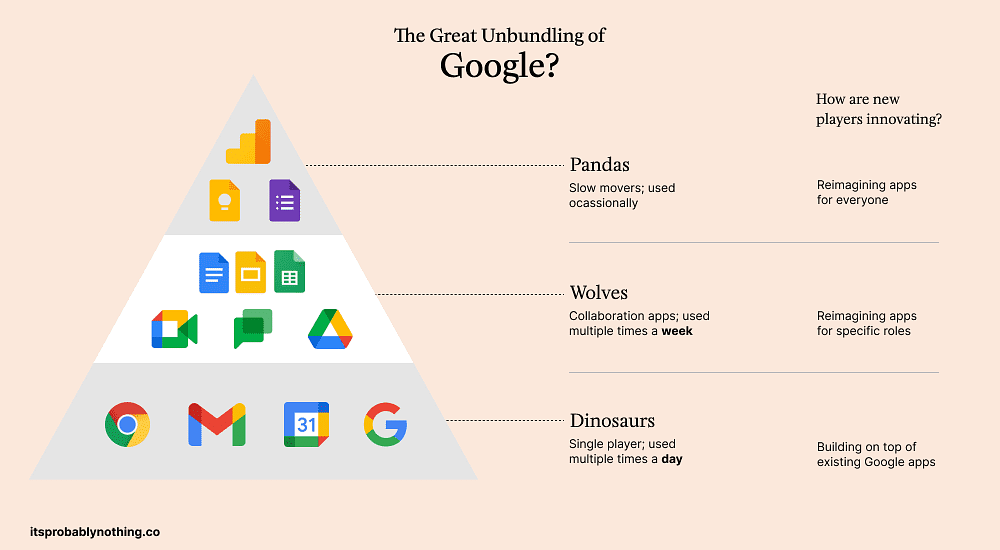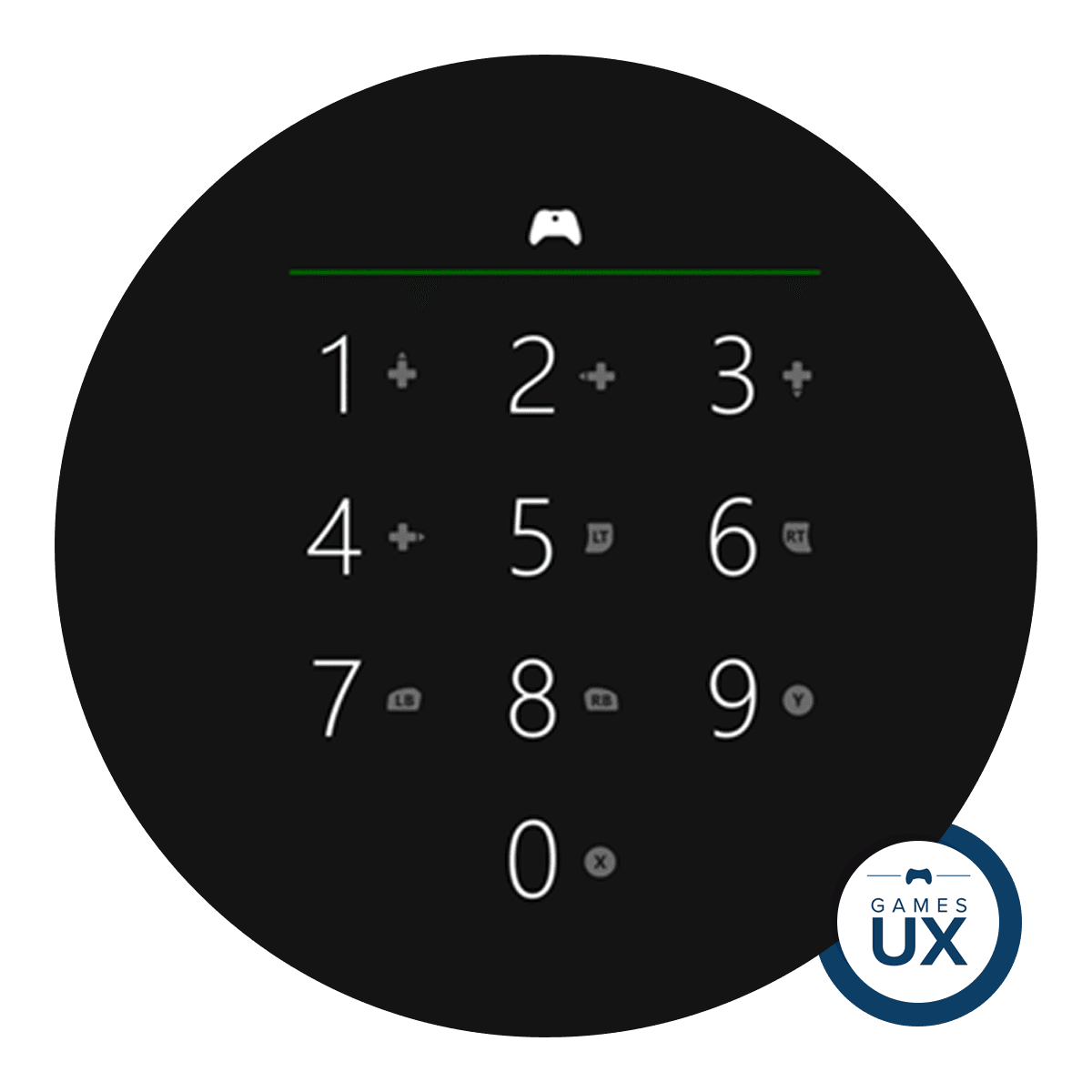The Google Workspace (and Microsoft Suite) have always been horizontal tools for knowledge workers. Now, we’re seeing purpose-built tools for those who want to stand out


Letter
A. Don’t have much time? Here’s the TL;DR

The recent discussion around the decline of Google Search got us thinking.
So, we turned our focus to Google’s suite of free apps.
Do we like the experience of the Google Apps? 🤔
Apps like Gmail, Google Calendar, and Google Slides are commonplace. But what do we really think of them?
If we don’t enjoy their experience, what are the best alternatives out there?
There are three types of alternatives (based on the biggest concerns users have with Google apps):
- Google has all my data → Privacy-focused
- Google is slow to respond, not fully customizable → Open-source
- Google’s experience is sub-par → Craftsman tools 👈 Our focus in this article
🚨 Get the full list of Craftsman Apps

B. What’s wrong with Google apps?
When was the last time you were frustrated 🤕 with a Google app?
The answer would depend a lot on how often you use it 😫
Be it managing your inbox with Gmail, scheduling events with Google Calendar, or connecting with others over Google Meets as it hogs your system memory — you quickly realize these apps weren’t made for users who spend a lot of time on them.
Just like a professional artist or sportsperson has their own set of tools that enable them to perform at their best, so does everyone else. Or at least we think we do.
When you see your favorite sportsperson wear a particular brand of shoe, your desire to emulate them in the best way possible:

The best tools signify the value a craftsperson places on time and efficiency. They’re emblematic of the role that craftsperson holds, signify their status and skill. And they’re honed over time to be best for that role.
Today’s positional software does the same. It’s best tools, designed for specific roles, carefully designed to make craftspeople better at their digital work. It’s software that positions you as an expert. It’s priced at a premium, and worth paying for — by those who need their features, and by those who want the status those features convey. They’re spread as digital artisans work in public, share their work, talk about their tools.
So, it’s simple:
The more time we spend using a product, the better experience we desire.
And if we find a product with a better experience that elevates our self-image or makes us a part of something bigger (with its positioning) we are instantly attracted to it.
Better Product = Elevated experience 🥰
10x Better Product + 10x Better Brand = Absolute no brainer 🤯
It is no wonder that Notion is a breakout star. It makes you a part of its movement for simplicity — in effort and design. And why Microsoft ‘copying’ it is only more good news. (Wrote about it on Medium the week Microsoft Loop was launched)
On a similar note, Zoom was crushing Hangouts before Google improved Meets. And tried some funny tactics.
I'm shocked that Zoom crushed Google in enterprise video conferencing.
Google: 1) owns calendaring, 2) has a video conferencing product, 3) has built video products at incredible scale, & 4) has many of the best engs on earth.
And yet Hangouts is much glitchier/worse than Zoom.
— Leo Polovets (@lpolovets) July 4, 2019
C. Bundling and Unbundling
Whenever something is built for everyone, rarely does it delight anyone 🤷
And it’s true for most of the Google apps. They were built to be free tools for the masses — to provide basic functionality that everyone needs. Google bundled together some of the most used tools (mail, calendar, calls, docs, slides, sheets etc.) in a free, one-size-fits all offering.
There was an obvious opportunity in unbundling and fine-tuning each of these tools for users who would need it most. For instance:
- 📧 Reimagining email for founders and CXOs who get a lot of mail and are short on time → Superhuman v/s Gmail/Outlook
- 📹 Video chats don’t need to be “Big faces in a box”. Different calls need different optimized experiences (e.g., All hands vs 1on1) → Around v/s Google Meets/Zoom

However, what happens next?
These innovators that target a specific problem are closely followed by the incumbents who attempt to emulate some of the best solutions. And combine it with their massive distribution — bundling it in their existing ecosystem at no extra price to the user. Examples are plenty:
- Microsoft Loop copied Notion
- Microsoft Teams copied Slack
- Google Meets borrowed from Zoom
- Fitbit copied Oura
Big tech attempts to bring some of these better experiences to the masses. But doesn’t execute well enough to satisfy the same audience:

Ed note: Unbundling and rebundling are not just present in productivity apps. Cable, music, media, real estate have all seen these cycles.

D. Not all (Google) apps are created equal — The indispensable and the invisible
While some apps (like Gmail) are used multiple times every day, there are others that are collaboration hubs (like Google Docs) and behind-the-scenes enablers (like Google Analytics and Forms).
Each of the three groups is being disrupted in a different manner:
- 🦖 Dinosaurs: Oldest apps with most frequent usage. Since the existing Google apps have a lot of leverage in terms of data and/or ecosystem, it is difficult to completely displace these apps like Gmail and Calendar. Disruption mainly takes place on top of existing Google apps to create a 10x better experience.
- 🐺 Wolves: Best used in collaboration; usually multiple times a week. A lot of innovation in this space has happened on top of existing Google apps — think plugins/add-ons in Docs and Sheets. Now everyone is realizing that the core of these apps needs rethinking to make them fast and simple. Disruption in this group mainly takes place as a completely new solution reimagined from scratch.
- 🐼 Pandas: Low fuss, behind-the-scenes performers that Google hasn’t paid much attention to. This is a mixture of internal and external apps that could’ve worked even better had they been tightly integrated with the Google ecosystem. As a result, this group sees the most competition.
While ‘the unbundling of Google’ is a common mention these days in articles and social media, I feel there’s a nuance to this concept. Users are NOT moving out of the Google ecosystem to use these disruptive apps, but are using some of these new apps alongside their Google counterparts.
A lot of these apps are paid for on top of using Google’s platform:
- Notion along with Google Docs
- Airtable along with Google Sheets
- Zoom along with Google Meets
More than unbundling, this is an entirely new class of experience and collaboration-driven software made for work, more persona/use-case focused.

Side note: If you’ve liked this until now, you’ll probably like my free newsletter about the latest products. The next Notion, Figma, and Calendly before they become breakout stars 🤩
Check it out here: The Probably Nothing Newsletter 🔮

E. So, what are the best craftsman apps out there?
The best future-of-work solutions are collaborative, ambi-sync (functions well both sync and async), and are thoughtfully crafted for specific roles/functions.

Most of these elegant, best-in-class products are approaching the market with product-led, bottom-up go-to-market motions. Our friends at Top of the Lyne write a ton of fun content on product-led growth in their newsletter.

F. Rebundling: The cycle continues?
We need binding glue to make our lives easier:
- 🧰 An overstocked toolbox: The last few years have seen an explosion in productivity tools — making work more complicated. Zoom calls now frequently involve users just switching screens from Notion to PowerPoint to Figma to some form of a spreadsheet. And this has accelerated during the pandemic.
- 😫 Apps that don’t play well together: Yes, you can embed a Miro board in Notion but the experience is subpar. It seems like an afterthought and not a core experience.
- 💸 Piling costs: An Okta report found that the average customer in 2018 had 80 installed work apps, an increase from ~50 apps in 2015. Of Okta’s Office 365 customers, 76% had one or more apps that are duplicative of a Microsoft app. While the Google/Microsoft suite is priced at $10–15/user/month, a stack comprised of Notion, Airtable, Figma (including Figjam), Slack can cost $40+/user/month on top.
The unbundling of work, which led to an explosion of disparate apps, created the need for products to find a way to ‘rebundle’. The focus is on convenience, organization, and focus.
This means all-in-one workspaces like Notion and Clover, window-into-your-work apps like Chronicle, and universal (smart) search tools like Raycast are emerging.
WMy old boss, Jim Barksdale, used to say there’s only two ways to make money in business: One is to bundle; the other is unbundle.
…and so, ironically, even the people who take down an incumbent through unbundling then come back and try to do the rebundle.
– Marc Andreessen
That’s it for now.
🤔 What do you think is going to be unbundled next? (Andrew Chen asked this recently)

If you’ve liked this, you’ll probably like my free newsletter focusing on the latest products. The next Notion, Figma, and Calendly before they breakout.
Check it out here: The Probably Nothing Newsletter 🔮
You can start off with a 👆custom onboarding in 2 mins.

This article originally appeared on Tejas’ Substack






